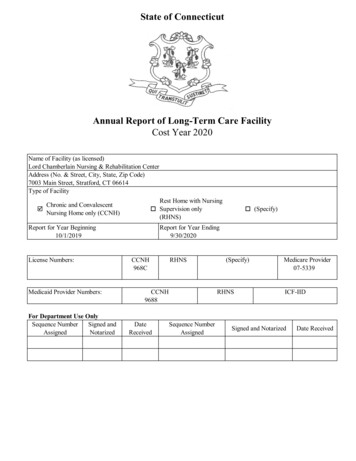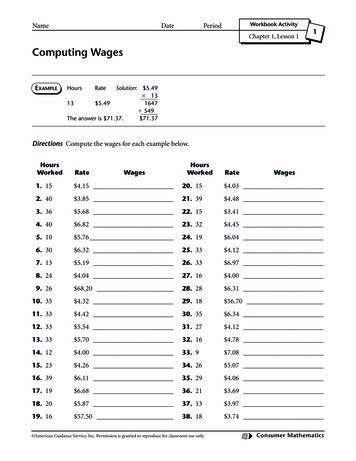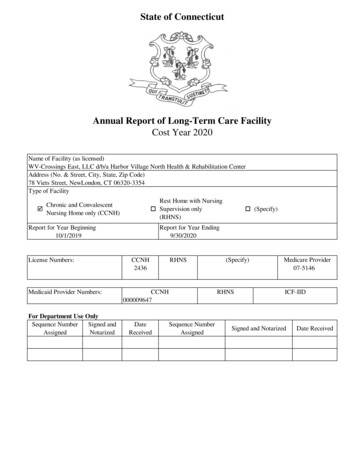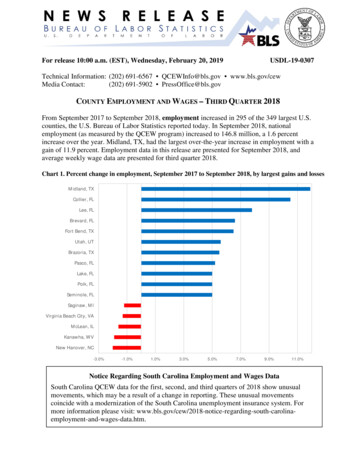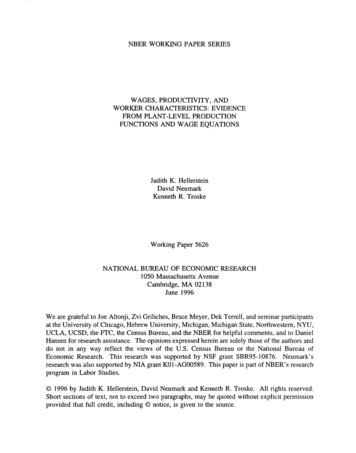
Transcription
NBER WORKINGPAPER SERESWAGES, PRODUCTIVITY, ANDWORKER CHARACTERISTICS : EVIDENCEFROM PLANT-LEVEL PRODUCTIONFUNCTIONS AND WAGE EQUATIONSJudith K. HellersteinDavid NeumarkKenneth R. TroskeWorking Paper 5626NATIONALBUREAU OF ECONOMIC RESEARCH1050 Massachusetts AvenueCambridge, MA 02138June 1996We are grateful to Joe Altonji, Zvi Griliches, Bruce Meyer, Dek Terrell, and seminar participantsat the University of Chicago, Hebrew University, Michigan, Michigan State, Northwestern, NYU,UCLA, UCSD, the FI’C, the Census Bureau, and the NBER for helpful comments, and to DanielHansen for research assistance. The opinions expressed herein are solely those of the authors anddo not in any way reflect the views of the U.S. Census Bureau or the National Bureau ofEconomic Research. This research was supported by NSF grant SBR95-10876.Neumark’sresearch was also supported by NIA grant KO1-AGO0589. This paper is part of NBER’s researchprogram in Labor Studies.@ 1996 by Judith K. Hellerstein, David Neumark and Kenneth R. Troske. All rights reserved.Short sections of text, not to exceed two paragraphs, may be quoted without explicit permissionprovided that full credit, including @ notice, is given to the source.
NBER Working Paper 5626June 1996WAGES, PRODUCTIVITY, ANDWORKER CHARACTERISTICS:EVIDENCEFROM PLANT-LEVEL PRODUCTIONFUNCTIONS AND WAGE EQUATIONSABSTRACTWe use a unique new data set that combines individual worker data with data on workers’employers to estimate plant-level production functions and wage equations, and thus to comparerelative marginalproductsand relative wages for various groups of workers.The data andempirical frameworklead to new evidence on numerous questions regarding the determinationof wages, questionsthat hinge on the relationshipworkers in different demographicgroups.between wages and marginal productsThese include race and sex discriminationthe causes of rising wages over the life cycle, and the returns to marriage.haveever beenaccordingly.marriedare more productiveSecond, prime-agedthan never-marriedin wages,First, workers whoworkersand are paidworkers (aged 35-54) are equally as productiveworkers, and in some specificationsofare estimated to receive higher wages.as youngerHowever,olderworkers (aged 55 ) are less productive than younger workers but are paid more. Third, the dataindicate no difference between the relative wage and relative productivityFinally, with the exception of managerial and professionaloccupations,of black workers.women are paid about25-35% less than men, but estimated productivity differentials for women are generally no largerthan 1570, and significantlyJudith K, HellersteinDepartment of EconomicsNorthwestern University2003 Sheridan RoadEvanston, IL 60208and NBERsmaller than the pay differential.David NeumarkDepartment of EconomicsMichigan State UniversityEast Lansing, MI 48824and NBERKenneth R. TroskeCenter for Economic StudiesEPCD, Room 211 -WPIIU.S. Census BureauWashington, DC 20233
I. IntroductionCompeting models of wage determination hinge on the relationships between wages,productivity,and worker characteristics.However, direct measures of worker productivityare hardto obtain, so economists usually rely on proxies for productivity when conducting empirical research.The difficulty with this approach is that whether these proxies reflect productivity is always in doubt,making it difficult to distinguish between competing models.This lack of data on worker productivity plagues numerous areas of empirical research relatedto issues of wage determination.For example, with data only on wages and worker characteristicsover the life cycle, it is difficult to distinguish human capital models of wage growth (such as BenPorath, 1967; Becker, 1975; Mincer, 1974) from incentive-compatiblemodels of wage growth(Lazear, 1979) or forced-saving models of life-cycle wage profiles (Loewenstein and Sicherrnan,1991; Frank and Hutchens, 1993). Typical wage regression results report positive coefficients onage, conditional on a variety of covariates, but these positive coefficients neither imply that olderworkers are more productive than younger ones, nor that wages rise faster than productivity.Similarly, without direct measures of the relative productivitiesof workers, discriminationby sex,race, or marital status cannot be established based on significant negative estimated coefficients onfemale or black dummy variables, or positive estimated coefficients on a married dummy variable, instandard wage regressions, since the usual individual-levelcapture productivitywage regression controls may not fullydifferences (e.g., Becker, 1985).To overcome these difficulties, we use a unique new data set that combines individual workerdata with data on workers’ employers to estimate and compare relative marginal products and relativewages for various groups of workers,CharacteristicsThis employer-employeedata set, the Worker EstablishmentDatabase (WECD), matches long-form respondents to the 1990 Decennial Census todata on their employers from the Longitudinal Research Database (LRD). These data are a major1
improvement over previously available data sources because they combine detailed demographicinformation on workers in a sample of plants with information on plant-level inputs, outputs, andlabor costs. ]We use these data to estimate production finctionscharacteristicsare perfectly substitutablein which workers with differentlabor inputs with potentially different marginal products,and plant-level earnings equations which represent the aggregation of individual-levelover workers employed in a plant.relative marginal productivitiesdemographicregressionsThe estimates of these equations allow us to compare theand relative wages of workers distinguishedby variouscharacteristics .2’3 Thus, the data and empirical framework lead to new evidence onnumerous topics regarding the determinationof wages, including race and sex discriminationinwages, the causes of rising wages over the life cycle, and the returns to marriage.II. The Relationship) BeWeen Wapes and ProductivityIL1 The Null HvDothesisIn order to motivate the approach we take in this paper, we first present the simplest modelillustrating the relationship between wages and productivity under perfect competition.Consider an‘However, they are somewhat limited in that they are only cross-sectional, ordy cover the manufacturing sector, andare weighted toward large plants.‘The WECD is a very rich and useful data set, and has so far been utilized only in a few other studies (Troske, 1994;Barrington and Troske, 1994). There are clearly many important issues which these data maybe able to address; we limitthis paper solely to the analysis of the relationship between the productivity and wage differentials among workers withdifferent demographic characteristics.‘This paper builds on the framework used in Hellerstein and Neumark (1994 and 1995, hereafter HNa and HNb) toanalyze Israeli manufacturing data (although the WECD offers numerous advantages over the Israeli data), and itrepresents a departure from most of the existing empirical literature on wage determination. As discussed in HNa andHNb, there is little existing research comparing productivity and wage data, and even less using firm-level data. Brownand Medoff ( 1978) estimate a production function using state-by-industry level data to test whether the union wagepremium is associated with higher productivity of union labor. Leonard (1984) uses similar data over time to examine theimpact of affirmative action laws on productivity in the U.S. One firm-level productivity and wage study examinesevidence of sex discrimination using data from the nineteenth-century French textile industry (Cox and Nye, 1989).Studies applied to more narrowly-defined industries have been pursued in the union literature (Allen, 1984; Clark, 1980).Other research has used proxies for productivity, including using piece-rate pay to measure productivity in time-rate work(Foster and Rosenzweig, 1993) and performance ratings (Holzer, 1990; Korenman and Neumark, 199 1; Medoff andAbraham, 1980).2
economy consisting of plants that produce output Ywith a technology that utilizes two different typesof perfectly substitutable labor inputs, L1 and L2. The production fanction of these plants is(1)Y F(L, L2),where @ is the marginal productivity of L2 relative to L,. These plants are assumed to operate inperfectly competitive spot labor markets, and labor supply is assumed to be completely inelastic.Theprice of the output Y is normalized to equal one. Wages of workers of types L, and L2 are w, and W2,respectively.Define the relative wage rate (w2/wl) to be A. Given this setup, the proportionalmix ofthe two types of labor in each plant will be determined by the relationship between and A. If A,then under profit maximizationor cost minimization plants will be indifferent to the proportional mixof the two types of labor in the plant. If there is a wedge between the relative marginal product andrelative wage so that @ A, then profit-maximizingor cost-minimizingplants will be at a comersolution, hiring either only workers of type L, (if A) or only workers of type L2 (if A). The onlyequilibrium in this model is when wages adjust so that 1, and plants are indifferent between thetwo types of labor.Evidence that #A is inconsistent with the assumption that we are observing profitmaximizing or cost-minimizingplants in a competitive spot labor market.4 This paper can beinterpreted as providing empirical tests of this characterizationvariants of the plant-level production tictionof labor markets.in equation (1) simultaneouslyequations in order to obtain estimates of and A for various types of workers.We estimatewith plant-level wageWe interpret caseswhere we cannot reject the equality of and k as evidence consistent with competitive spot labormarkets.Cases in which we reject the equality of@ and A indicate some deviation from thischaracterizationof labor markets, such as long-term incentive contracts or discrimination.4Labor supply could be less than completely inelastic; as long as market wages remain above reservation wages, theconclusions are unchanged.3
112 An Alternative Hvuothesis: DiscriminationOne such deviation that receives a lot of attention in this paper is labor market discrimination.If there is employer discriminationagainst L2 labor, as in Becker(197 1), then employers maximizeutility defined as(2)where d is the discriminationmaximizationU(n,L,,L2) F(L1 L2) - w,L, - W2L2- d.L2,coefficient capturing an employer’s distaste for L2. In this case utilityimplies(3) A dlw,implying that A.If d varies across employers, this case presents the problem that many firms should be atcorner solutions.Faced with the market wage ratio A, firms will hire only L2 if d MP1 - Wz,andonly L] if d @MP1 - W2. We do not appear to observe this type of segmentationthis predicted segmentationin hiring. However,is a result of the particular specification of employers’ discriminatorytastes. An alternative, considered in Neumark (1988), is(4)U(n,L,,L2) F(L, L,) - w,L, - W2L2 - d.[L2/L,].In this case, employers care about the relative level of L2, rather than the absolute level. Withthis utility fmction,maximization(5)of (4) implies [w, (d/L, )]/[w,-(d.L2/L,2)].In this case the marginal disutility from an additional unit of L2 labor is not fixed, but dependson the relative level of L2. Thus, even if d varies across employers, employers facing the same A willhire both L, and L2 labor. Of course, those with a higher value of d will hire less L2 and more Ll, asequation (5) shows. Thus, the simple employer discrimination4model with heterogeneityin
discriminatorytastes does not preclude all (or most) firms hiring both types of labor, even thoughthey face the same wage ratio.5III. A Structural Production Function ADDroachTo estimate parameters corresponding to --the relative marginal productivitiesof varioustypes of labor--we estimate a translog production finction in which the value of output Y is afinction of capital K, materials M, and a quality of labor aggregate QL.6 In logs, this is(6)ln( In(A) aln(K) ln(M) yln:( K, M,QL)p,where g(K,M,QL) is the second-order terms in the production function (Jorgenson, et al., 1973), andp is an error term.For each plant in our data set, we have demographic information on a sample of theirworkforce from the WECD.We assume that in the quality of labor aggregate QL, workers withdifferent demographic characteristics are perfectly substitutable inputs with potentially differentmarginal products.7 For example, assume that workers are distinguishedonly by sex. Then QLwould be defined as(7)QL L(I( F-l);),where L is the total number of workers in the plant, F is the number of women in the plant, and isthe marginal productivityof women relative to men. Substituting equation (7) into equation (6), we5Another well-known objection to this model is that employers with discriminatory tastes against a particular groupcannot survive in a competitive marketplace (Becker, 1971), However, Goldberg (1982) shows that we can frame themodel in terms of nepotism toward type L, labor rather than discrimination against Lj, in which case the results arequalitatively the same, but discrimination (actually, nepotism) will not be competed away.6The results reported in the paper were very similar when a Cobb-Douglas production function was used. The onlynoteworthy difference is that the evidence consistent with sex discrimination was stronger.‘Issues relating to this specification of the labor input are discussed in Rosen (1983). Below, we report some estimatesdropping the perfect substitutes assumption.5
obtain a production function with which we can estimate , using plant-level data on output, capitaland materials inputs, and data on the number of workers and the sex compositionof the workforce.We actually define QL to assume that workers are distinguished not only by sex but also by:race (black and non-black); marital status (ever married); age (divided into three broad categories-under 35, 35-54, 55 and over); education (defined as having attended at least some college); andoccupation (divided into four groups--(l)operators, fabricators, and laborers (unskilled productionworkers), (2) managers and professionals,(3) technical, sales, administrative,and service, and (4)precision production, craft, and repair), A firm’s workforce can then be fally described by theproportions of workers in each of 192 possible combinationsTo reduce the dimensionalityof demographic groups.of the problem, for much of our work we impose tworestrictions on the form of QL. First, we restrict the relative marginal products of two types ofworkers within one demographic group to be equal to the relative marginal products of those sametwo types of workers within another demographic group. For example, the relative productivityblack women to black men is restricted to equal the relative marginal productivityofof otherwiseidentical non-black women to non-black men. Similarly, the race difference in marginal productivityis restricted to be the same across the sexes. Second, we restrict the proportion of workers in anestablishmentdefined by a demographic group to be constant across all other groups; for example,we restrict blacks to be equally represented in all occupations, education levels, marital status groups,etc. We impose these restrictions due to data limitations.For each establishment,data on the actual number of workers in each of the 192 possible combinationscharacteristics,we do not haveof demographicbut instead estimate that number using our sample of workers matched to the plant. Itis likely, therefore, that we cannot obtain accurate estimates of the representationof workers innarrowly defined sets of demographic groups. For example, in many plants there are no workers inour sample in some of the demographic groups, even though it is likely that there are, in fact, some6
workers in these groups. Our restrictions on QL reduce the number of sample estimates based onsmall numbers of workers, as well as the number of parameters.The effects of relaxing theserestrictions on QL are considered in the empirical results below. To foreshadow the results, relaxingthe equiproportionateassumption with regard to the distribution of workers, even in cases in which itis least likely to hold (such as the distribution of men and women across occupations) has relativelyminor consequencesfor the results.With these assumptions, the quality of labor term in the production function becomesQL yln[(L (@F-l)F)(l (@B-l) )(l ( R-l) (l (@G-l)fi(8)(l (@, -l); (@o-l);(l (@N-l): (@,-l); (@c-l) ],where B is the number of black workers, R is the number of workers ever married, G is the number ofworkers who have some college education, P is the number of workers in the plant between the agesof35 and 54, 0 is the number of workers who are 55 or older, and N, S, and C are the numbers ofworkers in the second through fourth occupational categories defined above.8 Note that the way QLaFor example, suppose workers are distinguished by race and sex. Then the unrestricted quality of labor term isQL L ( F-l)WF (@B-l)BM ( F B” FXB-l)BF,where W is the number of white females, BM the number of black males, and BF the number of black females. Therestriction of equal relative marginal productivities implies o x 1. The equiproportionate distribution restrictionimplies BF B“(F/L), BF B( 1-(F/L)), and W F(I -(B/L)). Substituting, we obtainQL L ( F-l)F(l-(B/L)) (@B-l)B(l-(F/L)) ( F B@FxB-l)B(FIL)which reduces toQL (L (@F-l)F)(l7 (@, -l)(B/L)),,
is defined, productivitydifferentials between groups are indicated when the estimate of the relevant @is significantly different from one (rather than zero). For example, a finding of 1.3 would implythat ever-married workers are 30V0more productive than never-man-ied workers.9We also allow productivity to vary by size of plant (see Lucas, 1978; Baily, et al., 1992),industry, region, age of plant, and whether or not the plant is part of a multi-plant firm, by addingcontrols for these plant-level characteristics to the production function.’0Because materials are likely to be an endogenous input, when we estimate the productionfunction with output as the dependent variable, we instrument for materials with lagged materials.t 1If plants differ systematically(i.e., in a persistent manner) in terms of output, and the differences arecorrelated with materials, then lagged materials is not a valid instrument.differences over time are due to uncorrelated period-specificHowever, if the outputeffects, then a lagged value of materialsis a valid instrument.paralleling equation (8).91n the text of the paper, we sometimes report the estimate of , and whether it is significantly different from one, andsometimes refer to the implied percentage differential (@- 1), and whether it is statistically significant (i.e., significantlydifferent from zero). The tables report estimates of the ’s.‘OAsGriliches andRingstad(1971) point out, estimates of the fust-order terms in the translog production function arenot invariant to the units of the data. We therefore de-mean the (log ofi capital, materials, and labor quality inputs priorto estimating the production function, so that the coefficients on the productive inputs in the production function areestimated at the mean of the sample. Following Crepon and Mairesse (1993), we de-mean the log quality of labor term,ln(QL), by first estimating the translog production function without demeaning, constructing plant-level estimates ofln(QL), and then taking the mean over the sample of the estimated values of ln(QL). This allows us to measure the returnsto scale parameter by adding up the coefficients on the linear terms.1‘To instrument for materials, we form the predicted value of log materials, form the nonlinear variables involvingmaterials using this predicted value, and use the latter as instruments (Bowden and Turkington, 1984). We are mostworried about the endogeneity of materials, given that materials inputs are the easiest for firms to adjust in the short-run.Nonetheless, it is possible that capital and labor quality are also endogenous. We unfortunately do not have goodinstruments for these latter two inputs. First, as we discuss below, the capital measure we use in the production functionis actually a measure of lagged book value of capital. Second, the data on the demographic composition of workers in aplant is cross-sectional data, so we have no lagged measures of worker quality, nor do we have any other good candidatesfor instruments. To the extent that these problems affect the coefficients in the wage and productivity equations similarly,our test for the differences between relative wages and productivities should be unaffected, In Section VIII we return tothis issue in the context of omitted variable bias in the production finction.8
We also estimate a value-added version of the production fi mction, using /n -M)dependent variable.specification.Griliches mdWngstad(1971)listnmerousjustificationsas theforthe value-addedFirst, materials may be a particularly endogenous input, and the value-addedspecification avoids estimating a coefficient on materials.enhances comparabilitySecond, the value-added specificationof data across industries and across establishmentsindustries or establishmentsdiffer in their degree of vertical integration.within industries, whenThird, the value-addedspecification can be derived from quite polar production finction specifications:one in which theelasticity of substitution between materials and value added is infinite (i.e., Y f(K,QL) ;and onein which this elasticity of substitution is zero (so that materials have to be used in a fixed proportionto output).IV. Earninps Differentials Amonp WorkersWe have three compensationmeasures available in our data set: the plant’s total annual wageand salary bill; the plant’s total annual wage and salary bill plus expenditures on non-wagecompensation;and an estimate of the plant’s total annual wage and salary bill derived from oursample of workers matched to the establishment.For simplicity, in the following discussion we referto each of these measures as the plant’s total wages. We examine results with each of thecompensationmeasures.The plant-level wage equation we estimate for most of the results retains theequiproportionatedistribution restriction made in defining QL in the production function.(again paralleling the production fiction)demographicWe alsorestrict the relative wages of workers within agroup to be constant across all other demographic groups. Furthermore, we assume thatall workers within each unique set of demographic groupings are paid the same amount, up to amultiplicativerandom error. Then total log wages in a plant can be written as9
in(w) a’ ln[(L (AF-l)F)(l (AB-l) )(l (AR-l) (l (AG-l) (9)(l (A, -l) E (Ao-l)Q)(lL (AN-l) ! (a -l);L (Ac-l)}] E,Lwhere a‘ is the log wage of the reference group (non-black, never married, male, no college, young,unskilled production worker) and the 1 terms represent the relative wage differentials associated witheach characteristic.This plant-level equation can be interpreted as the aggregation over workers in the plant ofthe individual-levelwage equation.involving only men and women.To show this, consider a simpler version of the wage equationThe total wage bill in levels implied by equation (9) is(10)w w (L- w,F,where w and w are the average wages of men and women. This can be rewritten asw w (L-fl A wMF WM( (A -1) ,which in logs isin w a’ ln(L (A,-l)m,as in equation (9), where a’ ln(w ).Next, consider the individual-level(11)wage equation in levelsWi WMMi W Fi,where M, and Fi are dummy variables for men and women, respectively.Clearly, the aggregation ofthis equation over all workers in the plant yields equation ( 10), from which, as we have shown, thewage equation (9) can be derived.We interpret equation (9) not as a behavioral equation but simply a definitional one. Itassumes that all plants are wage takers in a competitive labor market so that wages do not vary10
systematicallyacross plants. 12 In order to relax this assumption somewhat, in the empirical analysiswe allow wages to vary systematicallywith industry, plant size, region, and age of the plant. 13 Inaddition, we include as regressors in the wage equation the capital and materials expendituresof theplant. These inputs in the wage equation may account for the possibility that capital and materials areproxies for unobserved ability of workers, possibly because of complementaritiesbetween capital andunobserved dimensions of skill (Griliches, 1970), or they may be proxies for other differences acrossplants that shifi wages.We estimate equation (9) jointly with equation (6). We then compare estimates of the k’swith the correspondingestimates of the ’s from the production function, and test whether therelative wages of workers with different demographic characteristics are significantly different fromtheir relative marginal products.V. The DataThe WECD, constructed at the U.S. Census Bureau, links information for a subset ofindividuals responding to the long form of the 1990 Decennial Census with information about theiremployers in the 1989 LRD. Long-form Census respondents report the location of their employer inthe prior week, and the type of business or industry in which they work. The Census Bureau thenassigns a code for the location of the employer, corresponding to a unique city block for denselypopulated areas, or correspondingto a unique place for sparsely populated areas. The Census Bureaualso classifies workers into industries using Census industry codes so that, in effect, respondents canbe assigned to a unique industry-locationall manufacturingestablishmentscell. The Census Bureau also maintains a complete list ofoperating in the U.S. in a given year, along with location and“AS discussed in Section II, this is the correct assumption to make given that we are testing the null hypothesis ofcompetitive spot labor markets.“We also estimate the wage equation and production function for various subsets of the data, in which case wagedifferentials across workers are not constrained to be equal in all plants.11
industry information for these establishmentsthat is similar to the data available for workers.it is also possible to assign all plants in the U.S. to an industry-locationconstructed by first selecting all manufacturingan industry-locationunique establishmentestablishmentscell. The WECD isin operation in 1990 that are unique incell. Then all workers who are located in the same industry-locationare matched to that establishment.Thus,cell as aThis results in a data set consisting of199,558 workers matched to 16,144 plants.To obtain data on a worker’s employer, these data must be matched to the plant-level data inthe LRD. The LRD is a compilation of plant responses to the Annual Survey of Manufacturers(ASM) and Census of Manufacturers(CM). The CM is conducted in years ending in a two or aseven, while the ASM in conducted in all other years for a sample of plants. The LRD contains plantdata from every CM since 1963 and every ASM since 1971. Data in the LRD are of the sort typicallyused in production finction estimation, such as output, capital stock, materials expenditures,number of workers.andIn addition, the LRD contains information on total salaries and wages and totalnon-salary compensationpaid by the plant in a given year (McGuckin and Pascoe, 1988).Since worker earnings and labor force information in the Decennial Census refer to 1989, wematch the worker data to the 1989 plant data in the LRD. Since 1989 is an ASM year, data are onlyavailable for a sample of plants. Furthermore, since plant-level capital stock information is onlyavailable in Census years, we require all plants to be in the LRD in both 1989 and 1987.14 Finally, toincrease the representativenessof the sample of workers in each plant, we require plants in our dataset to have at least 20 employees in 1989 (as reported in the LRD), and at least 5 /0 of their workforcecontained in the WECD.Our final sample contains data on 3,102 plants and 129,606 workers.Summary statistics for plant-level data are given in Table 1. The average plant has 353 employees,“Total capital in the plant is measured as the sum of the end-of-year book value of buildings and machinery in1987, Again, because 1989 is an ASM year, we use materials from 1987 when we instrument for materials in 1989,since in 1987 materials are available for most firms in the LRD as of 1989.12
and on average 12 /0of a plant’s workforce is matched to the plant.’5Troske (1993) concludes that workers are matched to their correct plants--basedon the matchrate and on high correlations between variables available in the two data sets--with approximatelySo/Oof workers from the Census long-form represented in the WECD. The matching process does not,however, yield a representativesample of workers, as non-black, male, married workers are over-represented in the WECD. Below we discuss some of the implications of this for our empiricalresults.VI. Individual-LevelWage Repressions with the WECD DataBefore turning to the results of the jointly estimated plant-level production function and wageequations, we report in Table 2 the results of individual-levelfrom the WECD.wage regressions using the wage dataThe wage regression results provide a comparison between the WECD data andstandard wage regression results reported elsewhere.More importantly, the plant-level wageequation is derived as the aggregation of individual-levelwage regressions, as explained above.Thus, comparing results from the plant-level wage equation with
productivity, and worker characteristics. However, direct measures of worker productivity are hard to obtain, so economists usually rely on proxies for productivity when conducting empirical research. The difficulty with this approach is that whether these proxies reflect productivity is always in doubt,

